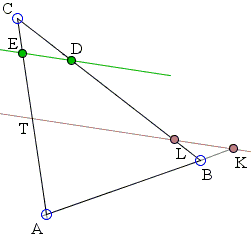Three Parallels in a Triangle: What Is It About?
A Mathematical Droodle
|
|Activities| |Contact| |Front page| |Contents| |Geometry|
Copyright © 1996-2018 Alexander Bogomolny
Three Parallels in a Triangle
The applet attempts to suggest the following statement:
|
On the sides of ΔABC six points D, E, K, L, M, N are constructed (see the applet) so that
Show that that the three lines DE, KL, and MN are parallel. |
|
In the proof we shall refer to the following diagram:

|
As usual BC = a, AC = b, and AB = c. In the diagram
We shall only prove that DE and KL are parallel. The claim that MN is parallel to the two can be bundled under the analogy argument above with a redistribution of magnitudes of the lengths a, b, c.
Let KL meet AC in T. According to Menelaus' theorem,
| (1) | AK/KB · BL/LC · CT/TA = -1, |
where by construction
| (a - b) / (c - b) = (x - b) / x = 1 - b/x, |
from which
| x = b(b - c) / (a - c). |
One way to show that DE is parallel to KL is to verify the proportion (where all segment length are assumed positive.)
| (2) | CE/CT = CD/CL. |
But, with CE = b - c and
| (b - c)(a - c) / b(b - c) = (a - c)/b, |
which is indeed true, thus confirming (2).
Nathan Bowler has offered a different and a much simpler approach:
EK is the reflection of BC in the bisector of angle A, so the point X where these lines meet is the intersection of BC with that bisector: It satisfies
| XD:XL = (BD - XB):(CL - XC) = c:b = XE:XK, |
so DE and KL are parallel.
Michel Cabart suggest a vector algebra shortcut (vectors are in bold):
| (3) | CE | = CA - c/b CA |
| (4) | CD | = CB - c/a CB |
Subtracting (3) from (4) gives
| ED | = AB - c/a CB + c/b CA |
Multiplying by ab leads to
| ab ED | = ab AB + bc BC + ca CA |
which is symmetric A, B, C and thus ensures that
(This statement has a bearing on an interesting property of the line joining the incenter and circumcenter of a triangle. In addition, the three lines are parallel to the line incident with the points of intersection of the external angle bisectors with the opposite sides. Also, points D, E, K, L, M, N are split into pairs lying on each of the side lines of ΔABC. Calculations show that the points in a pair are equidistant from the point of tangency of the incircle of ΔABC with the corresponding side line.)
|Activities| |Contact| |Front page| |Contents| |Geometry|
Copyright © 1996-2018 Alexander Bogomolny
71528329
